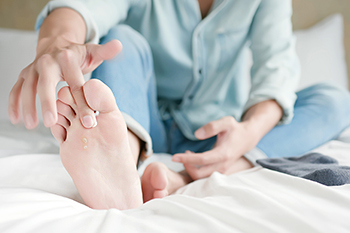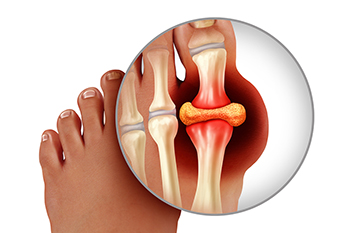Items filtered by date: May 2022
Injuries That May Happen From Sporting Activities

Research has indicated that artificial playing surfaces may increase the risk of getting a foot or ankle injury. This is despite the reasons artificial turf was introduced, which includes controlling environmental conditions on playing surfaces, and to lower the maintenance costs of natural grass. Additionally, 90% of North American professional football players have a higher risk of getting injured on an artificial surface. There are many professional athletes who understand foot structure, and the importance of strengthening the feet and ankles. Strong feet play a role in controlling balance in the body, and the ankle acts as a lever to provide flexibility. The sesamoid bones are a few of the smallest bones in the body. Sesamoiditis, which is an inflammation of the tissues surrounding the sesamoid bones, can be common among runners, dancers, and gymnasts. If you would like more information about foot injuries that are common among athletes, in addition to how they are treated, please consult with a podiatrist.
Ankle and foot injuries are common among athletes and in many sports. They can be caused by several problems and may be potentially serious. If you are feeling pain or think you were injured in a sporting event or when exercising, consult with our podiatrists from CNY Foot Surgery & Podiatry Care. Our doctors will assess your condition and provide you with quality foot and ankle treatment.
Common Injuries
The most common injuries that occur in sporting activities include:
- Achilles Tendonitis
- Achilles Tendon Rupture
- Ankle Sprains
- Broken Foot
- Plantar Fasciitis
- Stress Fractures
- Turf Toe
Symptoms
Symptoms vary depending upon the injury and in some cases, there may be no symptoms at all. However, in most cases, some form of symptom is experienced. Pain, aching, burning, bruising, tenderness, tightness or stiffness, sensation loss, difficulty moving, and swelling are the most common symptoms.
Treatment
Just as symptoms vary depending upon the injury, so do treatment options. A common treatment method is known as the RICE method. This method involves rest, applying ice, compression and elevating the afflicted foot or ankle. If the injury appears to be more serious, surgery might be required, such as arthroscopic or reconstructive surgery. Lastly, rehabilitation or therapy might be needed to gain full functionality in the afflicted area. Any discomfort experienced by an athlete must be evaluated by a licensed, reputable medical professional.
If you have any questions, please feel free to contact our office located in East Syracuse, NY . We offer the newest diagnostic and treatment technologies for all your foot care needs.
Prevention of Athlete’s Foot

Athlete’s foot is a common and contagious fungal infection of the skin. Common symptoms are dry, red, and cracked skin that generally develops on the bottom of the foot and in between the toes. It can spread to the toes and other areas of the foot if it is not promptly treated. This fungus can be uncomfortable and cause irritability and embarrassment. There are effective methods that can help to prevent athlete’s foot. These include wearing appropriate shoes while in public shower rooms or locker rooms and keeping your feet washed and thoroughly dried regularly. Additionally, it is advised to refrain from sharing shoes and socks. It is beneficial to wear shoes that are made of natural materials as this may help the feet to feel more comfortable. There are several treatment methods that respond well to athlete’s foot and it is suggested that you consult with a podiatrist who can determine which treatment options are best for you.
Athlete’s foot is an inconvenient condition that can be easily reduced with the proper treatment. If you have any concerns about your feet and ankles, contact our podiatrists from CNY Foot Surgery & Podiatry Care. Our doctors will treat your foot and ankle needs.
Athlete’s Foot: The Sole Story
Athlete's foot, also known as tinea pedis, can be an extremely contagious foot infection. It is commonly contracted in public changing areas and bathrooms, dormitory style living quarters, around locker rooms and public swimming pools, or anywhere your feet often come into contact with other people.
Solutions to Combat Athlete’s Foot
- Hydrate your feet by using lotion
- Exfoliate
- Buff off nails
- Use of anti-fungal products
- Examine your feet and visit your doctor if any suspicious blisters or cuts develop
Athlete’s foot can cause many irritating symptoms such as dry and flaking skin, itching, and redness. Some more severe symptoms can include bleeding and cracked skin, intense itching and burning, and even pain when walking. In the worst cases, Athlete’s foot can cause blistering as well. Speak to your podiatrist for a better understanding of the different causes of Athlete’s foot, as well as help in determining which treatment options are best for you.
If you have any questions please feel free to contact our office located in East Syracuse, NY . We offer the newest diagnostic and treatment technologies for all your foot and ankle needs.
Arthritis Can Cause Pain in the Feet and Ankles
Types of Foods That May Help Gout Attacks

An excess of uric acid in the blood can lead to the painful condition that is known as gout. Uric acid can come from eating foods that have high levels of purines. There are specific types of foods to avoid that can lead to gout attacks. These can include shellfish, red meat, and drinks that have large amounts of sugar. Additionally, there are foods that can be eaten that can possibly prevent and manage gout. These consist of cherries which have anti-inflammatory properties, and fresh or frozen juices. It can help to eat foods that are rich in vitamin C, and research has shown drinking coffee may decrease the risk of getting gout. Some patients prefer to eat foods that are plant-based, and staying hydrated is beneficial in controlling gout. If you have developed this condition, it is suggested that you consult with a podiatrist who can guide you toward the right treatment options.
Gout is a foot condition that requires certain treatment and care. If you are seeking treatment, contact our podiatrists from CNY Foot Surgery & Podiatry Care. Our doctors will treat your foot and ankle needs.
What Is Gout?
Gout is a type of arthritis caused by a buildup of uric acid in the bloodstream. It often develops in the foot, especially the big toe area, although it can manifest in other parts of the body as well. Gout can make walking and standing very painful and is especially common in diabetics and the obese.
People typically get gout because of a poor diet. Genetic predisposition is also a factor. The children of parents who have had gout frequently have a chance of developing it themselves.
Gout can easily be identified by redness and inflammation of the big toe and the surrounding areas of the foot. Other symptoms include extreme fatigue, joint pain, and running high fevers. Sometimes corticosteroid drugs can be prescribed to treat gout, but the best way to combat this disease is to get more exercise and eat a better diet.
If you have any questions please feel free to contact our office located in East Syracuse, NY . We offer the newest diagnostic and treatment technologies for all your foot and ankle needs.
Children Can Experience Heel Pain Too

It may be difficult for you to know if your child is having heel pain because it is not often associated with children. However, certain conditions that cause heel pain can afflict the young, even if they do not know how to properly communicate their distress. Sever’s disease, for instance, is a form of heel pain that stems from irritation to the growth plate in the heels of growing children. Children can also develop plantar fasciitis from overuse of the heel or wearing shoes that do not fit. This condition is a painful inflammation of the plantar fascia tissue that connects to the heel to the toes. Active children can also develop tiny stress fractures of the heel bone which can occur gradually over time and be quite painful. There are certain clues your child’s condition may provide if you know what to look for. If your child limps or changes the way they walk or run, cuts back on physical activities, complains that their feet or heels feel odd or stiff, or that something is stuck in their shoe, they may have a painful heel condition. It is suggested that you make an appointment for your child with a podiatrist to have your child’s condition diagnosed and treated properly.
The health of a child’s feet is vital to their overall well-being. If you have any questions regarding foot health, contact our podiatrists of CNY Foot Surgery & Podiatry Care. Our doctors can provide the care you need to keep you pain-free and on your feet.
Tips for Keeping Children's Feet Healthy
- Make sure their shoes fit properly
- Look for any signs of in-toeing or out-toeing
- Check to see if they have Clubfoot (condition that affects your child’s foot and ankle, twisting the heel and toes inward) which is one of the most common nonmajor birth defects.
- Lightly cover your baby’s feet (Tight covers may keep your baby from moving their feet freely, and could prevent normal development)
- Allow your toddler to go shoeless (Shoes can be restricting for a young child’s foot)
- Cut toenails straight across to avoid ingrown toenails
- Keep your child’s foot clean and dry
- Cover cuts and scrapes. Wash any scratches with soap and water and cover them with a bandage until they’ve healed.
If you have any questions, please feel free to contact our office located in East Syracuse, NY . We offer the newest diagnostic and treatment technologies for all your foot care needs.
Understanding the Risks of PAD

PAD or Peripheral Artery Disease occurs when there is a narrowing or blockage of blood vessels. This disease is caused by a buildup of fat in the arteries, and is also known as atherosclerosis. Though this can happen in any blood vessel, it is more common in the lower extremities. Risks for PAD include aging, smoking, high blood pressure, high cholesterol, and diabetes. Some symptoms that may be present include pain in the feet or legs with activity that stops with rest, decreased or absent foot pulse, sores or ulcers that do not heal, and cold or numb toes. Beyond damage to one’s feet if left untreated, PAD can lead to a heart attack or stroke. If you have any of these symptoms, it is important to see a podiatrist to measure blood pressure in the ankles via an ankle brachial index (ABI) and compare that to blood pressure in the arms, do possible imaging studies, confirm the diagnosis, and obtain a treatment plan.
Peripheral artery disease can pose a serious risk to your health. It can increase the risk of stroke and heart attack. If you have symptoms of peripheral artery disease, consult with our podiatrists from CNY Foot Surgery & Podiatry Care. Our doctors will assess your condition and provide you with quality foot and ankle treatment.
Peripheral artery disease (PAD) is when arteries are constricted due to plaque (fatty deposits) build-up. This results in less blood flow to the legs and other extremities. The main cause of PAD is atherosclerosis, in which plaque builds up in the arteries.
Symptoms
Symptoms of PAD include:
- Claudication (leg pain from walking)
- Numbness in legs
- Decrease in growth of leg hair and toenails
- Paleness of the skin
- Erectile dysfunction
- Sores and wounds on legs and feet that won’t heal
- Coldness in one leg
It is important to note that a majority of individuals never show any symptoms of PAD.
Diagnosis
While PAD occurs in the legs and arteries, Podiatrists can diagnose PAD. Podiatrists utilize a test called an ankle-brachial index (ABI). An ABI test compares blood pressure in your arm to you ankle to see if any abnormality occurs. Ultrasound and imaging devices may also be used.
Treatment
Fortunately, lifestyle changes such as maintaining a healthy diet, exercising, managing cholesterol and blood sugar levels, and quitting smoking, can all treat PAD. Medications that prevent clots from occurring can be prescribed. Finally, in some cases, surgery may be recommended.
If you have any questions, please feel free to contact our office located in East Syracuse, NY . We offer the newest diagnostic and treatment technologies for all your foot care needs.




